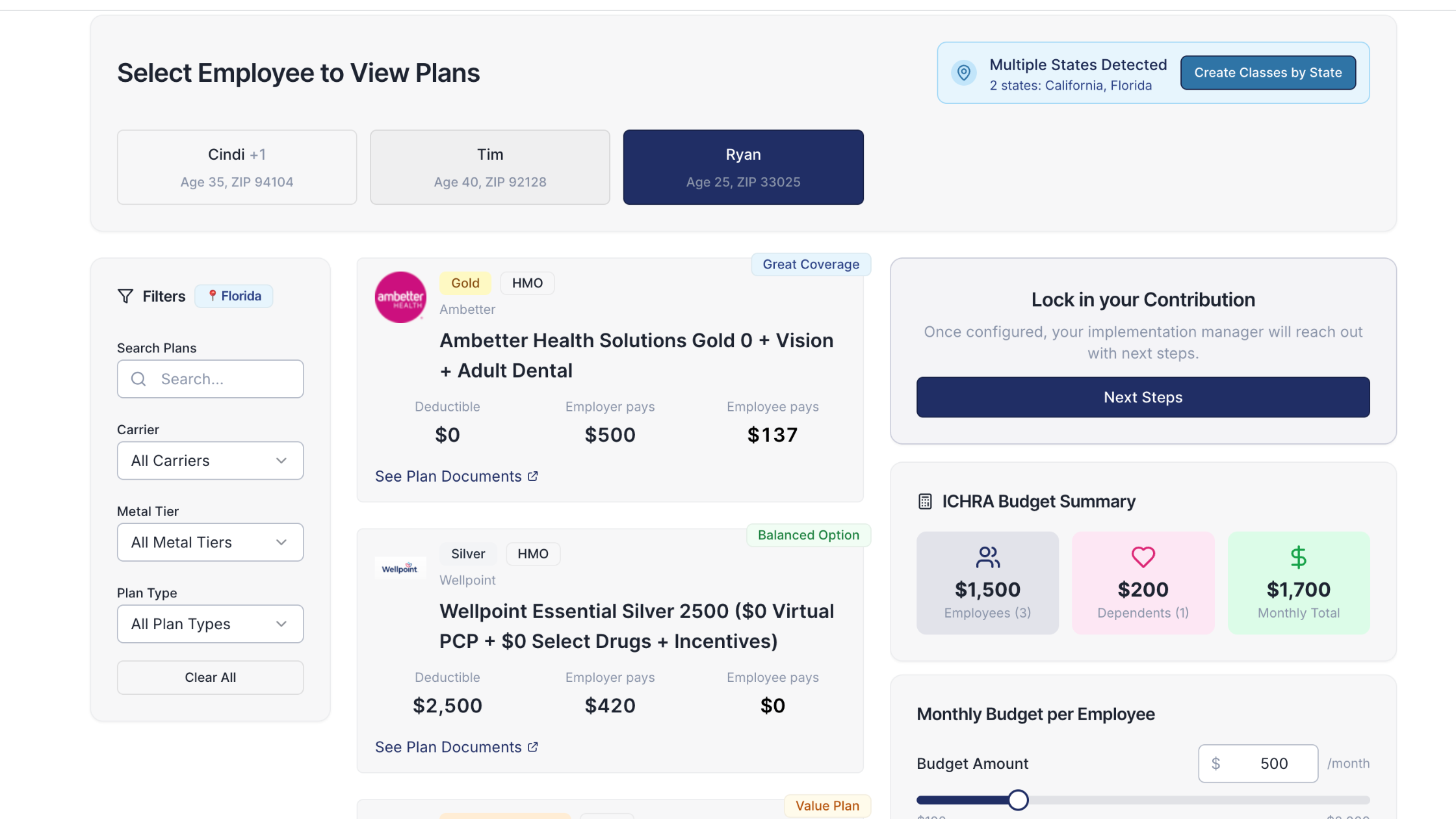Why the Health Wallet Is the Hidden Power Move in Your ICHRA Strategy

Many brokers and employers believe that ICHRA dollars can only be used to reimburse health insurance premiums. They're wrong.
You can allocate a portion of your ICHRA funding to a Health Wallet for out-of-pocket expenses. The key is that the employee must select an individual insurance plan that costs less than their total monthly ICHRA allowance. The unused portion of that allowance is then 'unlocked' and available for reimbursement of out-of-pocket costs.
Approximately half of our clients now structure their ICHRA in this manner. At Venteur, one-third of total health benefits spend flows through Health Wallets, not premiums. We believe this funding model builds a culture of wellness.
Here's why it works:
ICHRA & Health Wallet
An ICHRA (Individual Coverage Health Reimbursement Arrangement) is an employer-funded benefit that enables businesses to provide employees with a cash allowance for health benefits. This money is tax-free for both the employer and the employee.
How it works:
- The employer sets the budget
- The employee shops for their individual health insurance coverage.
A Health Wallet is part of the ICHRA and can be used to pay for qualified medical expenses under Section 213(d)—the same expansive list that governs HSAs and FSAs. That includes thousands of eligible items, from medical devices to therapy to gym memberships (with a letter of medical necessity).
How to Structure Your ICHRA Health Wallet
Employers have the discretion to offer a Health Wallet and determine its configuration, most notably the rollover policy (what happens to unused funds at the end of the year).
Health Wallet ICHRA Rollover Options
Full Rollover: Employees retain the entire unused balance year over year. However, if an employee leaves employment, the money reverts back to the company.
This approach fosters long-term strategic thinking about health and serves as a powerful employee retention tool. Employees treat the wallet like a Health Savings Account (HSA), investing in preventive and advanced care options, such as diagnostics, functional medicine, and longevity platforms, knowing the funds will remain available.
Partial Rollover: Employees retain a portion of the Health Weallet rolls over, often capped at thresholds like $500 or $1,000
This middle path encourages employees to use their funds while preventing the buildup of excessive balances.
No Rollover (Use It or Lose It): The Health Wallet expires annually.
Employees typically utilize only 50% of their Health Wallet funds, which often results in additional savings for the group and a potential refund check to the employer the following year.
What Do Employees Actually Do With Their Health Wallet?
Here's what we're seeing in real utilization data:
Prescription savings. Employees are using cash-pay pharmacy platforms to bypass insurance markups. A 90-day supply of a common medication might cost $8 through a cash program versus $45 through insurance. The wallet makes this arbitrage possible.
Preventive and longevity care. Advanced bloodwork panels, continuous glucose monitors, executive physicals, functional medicine consultations—things insurance doesn't cover but employees want. These aren't "wellness programs." They're proactive health investments.
Mental health. Out-of-network therapy and coaching, where most therapists bill in cash, are covered, providing a significant benefit here. Mental health is chronically under-covered by traditional plans, and the wallet effectively fills this access and cost gap.
Catastrophic protection. When serious health events happen—cancer, transplants, high-risk pregnancy—employers are using the wallet to buy down out-of-pocket maximums. Instead of watching an employee hit a $9,000 deductible, the employer funds the wallet to absorb that shock.
Everyday care. Copays, dental cleanings, vision exams, contact lenses, orthotics, and physical therapy. The unglamorous aspects that insurance either doesn't cover or requires employees to pay for upfront.
The common thread: employees are spending on things that matter to them, not on things HR thinks should matter.
Why This Works
Every year, employers spend millions on wellness point solutions, coaching platforms, and biometric screenings. The pitch is always the same: get people healthier, reduce claims, lower costs.
Employees know what's happening. They can tell when a program is designed to manage them, not support them. So engagement rates hover around 10% at best, vendors cycle every two years, and nothing actually changes.
The Health Wallet flips the model. Instead of prescribing solutions, you fund the account and let employees make the decisions. Some will spend on fitness. Others may benefit from therapy, nutrition, sleep, preventive diagnostics, or simply covering the cost of basic care without financial stress.
It's not a wellness program. It's a trust signal.
And that changes the relationship. When employees see their employer putting real dollars directly into their hands, they engage differently. The math works because the money goes where it's actually needed, not where a vendor wants to track engagement metrics.
The Bottom Line
The Health Wallet takes an ICHRA into a competitive differentiator and a powerful recruiting tool:
- Filling the Gap: Half of our clients adopt the Health Wallet because their employees require more than just premium reimbursement. They need coverage for the significant gap between "what insurance pays" and "what health actually costs."
- Driving Value: One-third of our total spend flows through these wallets because that's where employees have the most control and where they perceive the greatest direct value.
- The Critical Decision: If you are evaluating an ICHRA or already administering one, the question is not whether you can add a Health Wallet; the question is whether you should. You absolutely can. Ultimately, the decision comes down to whether you are willing to trust your employees to spend the funds wisely.
In our experience, they do.
You got questions, we got answers!
We're here to help you make informed decisions on health insurance for you and your family. Check out our FAQs or contact us if you have any additional questions.
Explore more related content
What is Venteur
Explore the best human-first Health Insurance platform
Simple, personalized health benefits
Sign up in minutes, define your contribution, and let your employees choose the health plan that works right for them
Integrations to make everything run smoothly
We'll connect with your payroll and finance systems to make deductions and premium payments seamless
Easy onboarding and off-boarding
In just a few clicks, add your roster and make updates on the fly. We'll handle it from there.
Venteur Certified Brokers to help your employees pick the right plan
Our trusted brokers ensure the best outcomes for employees and employers by unlocking health savings and providing unrivaled plan options.
AI-powered plan recommendations to give you confidence while you shop
Backed by 30 years of healthcare data, Venteur’s AI helps employees compare and choose the best plan for their unique situation.
Compliance and reporting because no-duh!
Venteur manages plan administration, reporting, and compliance so you can focus on growing your business.


